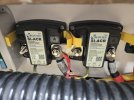John Cortesy
Member
- Joined
- Oct 27, 2024
- Messages
- 15
- Non-Fluid Motion Model
- Wellcraft 22 Walkaround
- MMSI Number
- 338457987
So my battery charger has quit charging. It is an AC1220 and after multiple resets just keeps flashing error 09. The book claims that there is high voltage on one of the battery lines, over 17 volts, but all three banks show between 12.5 and 13.3 at the output bolts on the charger. Anyone have any ideas on what might be going on? I am stumped.



